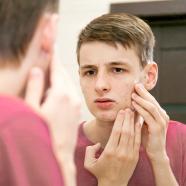Cutaneous psoriasis is a chronic inflammatory disease of the epidermis. It is characterised by the appearance of red patches on the body, covered by white scales. The scales are small flakes of dead skin that are shed.
It is a disease that affects 2 to 3% of the population, i.e., around 2.3 million people in France. It can be seen at any age but most often occurs between 20 and 40 years of age. It is not contagious and progresses in flare-ups.

What is psoriasis?
The origin of the disease is an immune system dysregulation that causes inflammation of the skin and overproduction of epidermal cells (keratinocytes), which leads to accelerated epidermal turnover, taking only seven days instead of three weeks. Keratinocytes then accumulate on the surface of the skin and form white flakes.
It is a disease linked to a background of genetic predisposition: in 30% of patients, psoriasis was found in the family and several genes have been identified. On top of this predisposition, favourable environmental factors intervene such as infections (particularly in children) certain medicines, stress or psychological shock. Alcohol and tobacco are aggravating factors for the disease.
Psoriasis affects social life and is difficult for the patient to accept. The aesthetic impact is significant and patients may feel negatively about how others see them. It can lead to a depressive state.
The different types of psoriasis
Psoriasis is a skin disease that takes different forms depending on the location and appearance of the plaques on the skin. Severity is extremely variable depending on the type of psoriasis and the affected skin surface.








Psoriasis is not just a skin disease.
In 20% of cases, cutaneous psoriasis is associated with psoriatic arthritis. This can affect the axial joints of the spine and pelvis or the peripheral joints of the knees, feet, hands, etc. One or more joints may be affected. It is an inflammatory rheumatic disease that causes joint pain, especially during the night with stiffness upon waking. There is no relationship between the intensity of skin lesions and the existence of rheumatism. Psoriatic arthritis can also occur in the absence of skin lesions.
Obesity and diabetes are also more common in patients with psoriasis.
Psoriasis prevention and treatment
As it is a disease with a genetic predisposition, a definitive cure cannot be envisaged. However, psoriasis is getting better !

Treatment
Many treatments lead to resolution of plaques and flare-ups. Topical treatment may be sufficient in forms which are not widespread.
In more severe forms, there are very effective systemic treatments, in tablet or injection form.
Exposure to natural sunlight in moderation or in a cabinet under medical supervision is also a useful treatment.
French Psoriasis Association
This is a patient association. Its main missions involve :
- restore hope,
- improve the care pathway,
- encourage research,
- raise awareness about psoriasis and psoriatic arthritis
For more information : www.francepsoriasis.org/









